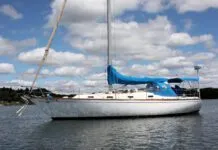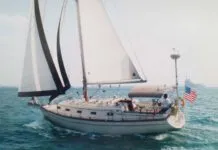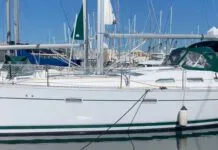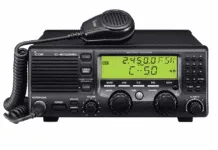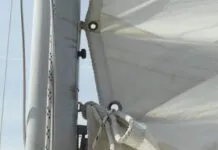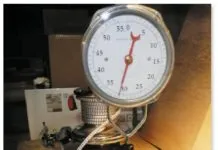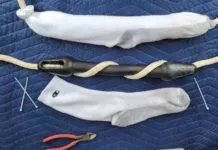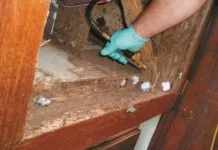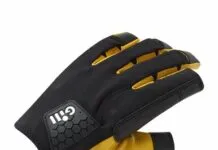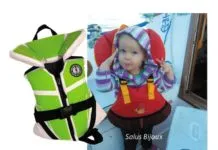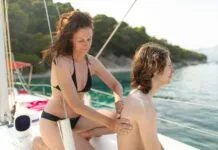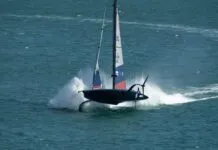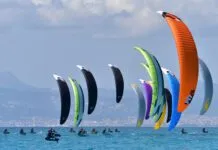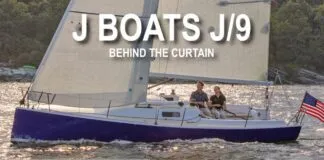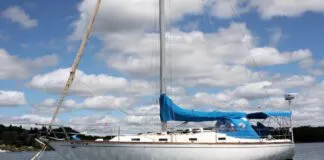Not everyone knows that a “naiad” is a water nymph. Nor might all sailors know that Najad is a Swedish builder of top-shelf cruising boats. After sailing the recently-introduced Najad 380 in a pluperfect, 12-knot sou’wester off Jamestown, RI, we came away convinced that “Najad” is a name worth knowing.
Located on the island of Orust on the west coast of Sweden, the Najad boatyard anchors the small town of Henan—a quiet cove “with shipbuilding traditions that date back to the Vikings.” Founded by Berndt Arvidson in 1971, and dedicated to “advanced design leading to innovation based on tradition,” this company has launched some 1,800 boats since its beginnings. Grown now to employ 115 people who work in an ultra-modern, 50,000-sq.-ft. facility, Najad was recently purchased by a group headed by Dutch financial consultant Alfred van Wincoop.
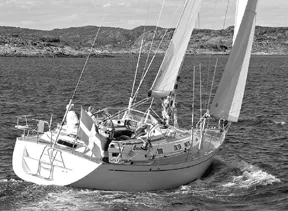
The company builds blue-water cruisers distinguished by their fixed windscreens. (Sailing in Scandianavia can be rugged, and good protection is appreciated.) According to company literature, the 380’s overall aura is “crisp, Scandinavian, and purposeful.” That may seem somewhat vague, but consider that there’s a Mediterranean-style swim platform, sybaritic expanse of teak deck, a nicely-sprung sheerline, and a modern 15/16 fractional rig. The emphases of this center-cockpit cruiser are an arrangement that provides maximum privacy in two cabins, good sailing ability, and good looks. She’s an interesting mix of go-anywhere function, top-of-the-line detailing, and reasonable performance. She is also (as evidenced in her price tag—well over $300,000) testimony that these niceties don’t come cheaply.
The Design
Najad’s design partner since 1998 is the well-known Hamburg, Germany marine engineering office of Judel-Vrolijk & Co. Along with the normal naval architect’s input, this firm provides intense, step-by-step oversight of the building process, and is also involved in quality control, interior detailing, cost accounting, production efficiency, and even sales and marketing. Its relationship with Najad is thus a genuine partnership.
But Judel-Vrolijk is notable for much more. The creators of more than 350 designs to date, Dutchman Rolf Vrolijk and German Freidrick Judel set up shop in 1978 to pursue their talents in race boat design. It took them until 1983 (when they designed all three boats on the winning Admiral’s Cup team from Germany) to reach the pinnacle, but they’ve been at or close to the top of the competitive world ever since. As an example, most recently Vrolijk was the chief designer for Team Alinghi, winner of the 2003 America’s Cup. From Whitbread 60s to top dinghies and in virtually every corner of the sailing world under all conceivable rating systems, the company has enjoyed major racing success.
In addition to those enviable race results, the firm (Torsten Conradi became the third member of the Judel-Vrolijk Design Team in 1993) has also had success working with and for production boatbuilders. Companies like Dehler, Hanse, Baltic, and Grand Soleil have depended on the firm’s grasp of what makes boats fast in order to create top-performing cruising boats. Beginning with the Najad 490 in 1997, Judel-Vrolijk began doing exactly that for Najad.
Tim Ulrich, a designer with Judel/Vrolijk, explained the company’s design philosophy: “Compromises are always involved. Take the rig. Our challenge with the 380 was to find the optimum power with the greatest ease of handling and cruising versatility. The sailplan consists of a tall (15/16) working jib providing the longest possible leading edge for upwind efficiency, plus enough area for speed. The other sail is a large (450 sq. ft.) mainsail. An overlapping genoa (140%) is available as an option, but we feel that the proportions and balance of her working sails are ideal for most conditions.”
The jib trims inboard for tight sheeting angles, is small enough to make tacking simple for shorthanded crews, and marries nicely with a generous, controllable mainsail. The headstay reaches almost to the masthead. This “slightly fractional” arrangement allows for control of both headstay tension and mainsail shape via the backstay while at the same time the two-spreader rig is neither too sensitive nor too complicated for normal cruising.
“Designing the hull presents a tension between the ideal shape for sailing and the volume necessary for cruising,” explained Ulrich. “The Najads in general and the 380 in particular are slimmer and more ‘veed’ in their foresections than most cruisers. Not only does this provide good seakeeping and an easy entry, but it gives them a grip on the water similar to that enjoyed by a raceboat.”
The midsections of the 380 are relatively round (to minimize wetted surface and maximize volume). There is also a bit more rocker in the canoe body, which, Ulrich pointed out, breeds a comfortable motion in waves and makes the boat easy to turn. The stern quarters are most definitely U-shaped. The flat bottom of the “U” helps add form stability and reduce wetted surface still further. The shape also serves to provide added waterline length when the boat heels and thus boost the 380’s top-end speed potential.
In the appendages, the tension between performance potential and cruising reality plays out again. “The rudder,” Ulrich told us, “is a relatively high-aspect ratio form, but both its chord length and thickness make it a low-stall foil geared to work well through a wide range of conditions. In addition, for protection and tracking, it is hung from a vestigial skeg.”
The same balance between efficiency and sensitivity shows up in the keel. Its relatively long chord length and thick foil sections make it forgiving, and help it work well in waves and through tacks. It is also generous, for a modern design, in lateral plane; its profile is a familiar swept-back leading edge (offering reduced drag) planform. Maximum lift and minimum wetted surface were subordinated here to a conservative, all-round answer that resonates with Najad’s respect for tradition. The standard keel draws 6′ 4″, but a 5′ 4″ shoal-draft version is available.
“Weight is a big part of the challenge with cruising boats,” said Ulrich. “We make a minimum of three loops in the design process focusing on weight, trying to eliminate it, or move it lower in the boat. With a boat like this, however, we are always looking for the robust solution. We never cut corners to save weight.”
The 380 displaces a healthy 18,260 lbs. She is no featherweight among boats of her size, but designer and builder have given her the tools and the horsepower to throw that weight around. Her sail area/displacement ratio of 18.26 compares well to her often more lightly-built competitors (see Najad 380 In Context sidebar, pg. 27). In addition, her ballast/displacement ratio of a solid 35% and low center of gravity, orchestrated by Admiral’s and America’s Cup winners, promise to let her be stiff enough to carry sail well. However, her tried and true foils, her considerable heft, and her cruiser-friendly sailplan put some limits on her performance potential. When compared to the rockets that have kept the Judel/Vrolijk bread buttered for lo these many years, the Najad 380 definitely falls toward the “cruisy” end of the spectrum.
On Deck
The 380 we sailed had a dodger-house, which is essentially a structure of canvas, stainless rails, soft windows, and zippers that fit beneath the boom and over the steering station to completely enclose the cockpit. Many Scandinavian boats have similar fixtures, we’ve learned. This convertible room isn’t tall enough to rival a genuine pilothouse, but it folds out of the way surprisingly quickly and offers virtually complete protection from sun, rain, and spray. And diesel generated heat (which is standard in the cabin of the 380) can be pumped into the cockpit if you choose that option. One downside of the arrangement, we felt, was that the supports for the expanse of canvas overhead obstructed the boat’s double-ended mainsheet.

The 380’s center cockpit gives her a profile that is better-looking than most boats of this ilk. It also offers good weather protection and a cozy feel. Sailors on this boat, however, will always be a bit higher off the water than they might be accustomed to.
The seat backs are passably high at 12″, but we felt that they could have been higher for security and comfort. On the positive side, the coaming heights make for a manageable step in and out of the cockpit, which adds to the ease of working the boat. We found, however, that having to step up and around the wheel (which is wider than the cockpit footwell) was annoying, and by trapping the helmsperson behind it, the wheel presents a potential problem for sailhandling with a shorthanded crew.
With sails that are permanently hoisted and live on roller furlers, the 380’s halyards are controlled from the mast, which is a clean solution. Her angled, eight-foot genoa track is close enough to the house to offer clear passage fore and aft on the sidedeck and is fitted with two sets of jib cars, (both capable of remote adjustment)—one for the working jib, another for a genoa. The primary winches, set on islands outboard of the cockpit, are a bit farther from the helm than we’d like, but the electric Andersen self-tailing winches on our 380 worked effortlessly with the push of a conveniently located button. The helmsman has better access to the mainsheet than is the norm on cruising boats: it trims from the two aft corners of the cockpit. However, we didn’t like the rope clutches in the system. Self-tailers are simpler and safer, we feel.
Najad uses wood at every turn. Deck and swimming platform are laid with solid teak planks, as are the seats and upper coaming tops in the cockpit. There are teak grab rails and a teak caprail. Most unusual were twin teak cockpit tables on either side of the companionway. Eye-catching solid sculptures in wood, they add warmth to an area that is usually austere. Fitted with no-nonsense fiddles, they not only look great, but should make topside life more convenient. It’s our conviction, however, that there’s no such thing as maintenance-free wood. Eye-appealing and captivating as the 380’s exterior is, it will take substantial effort and expense to keep it that way.
Accommodations
The accent on wood continues below. The furniture and trim are rendered in African mahogany “unstained, hand-polished, and varnished to a satin finish.” White tiles accented with fore-and aft mahogany battens form the overhead. A well-matched teak-and-holly sole (plywood) is underfoot. In between, the joinery and wood-wisdom that make up the Najad heritage have been given free rein. Matches are meticulous, grains are highlighted, joints are precise, and curves are appealing. Few are the builders who don’t attempt to woo you with wood when you come below, but few of them do it better than Najad. And it goes beyond the cosmetic. The timber supports for the saloon settees are out of sight, but the 4″ by 4″ timbers fitted there are the epitome of solid—excellent examples of the way well-built furniture contributes to a quiet, strong, and sturdy boat. The berth bottoms (fore and aft) are unvarnished and ventilated with holes to avoid dampness. The bulkhead separating the saloon and galley flows into an integrated handhold that is not only a joy to see, but perfectly placed for the cook’s convenience. There’s a twin handhold opposite on the half bulkhead that separates the starboard settee from the nav station.
Like most center-cockpits, the layout on the 380 takes advantage of the way the cockpit divides the boat. Aft is a master cabin with double, settee/berth, vented hanging locker, cupboards, and cabinets. Stowage is good and ventilation (via two opening ports and a skylight) is much better than one would expect. Built-in blind/screen assemblies on the hatch are a thoughtful amenity. And there is standing headroom in the passageway (to port) that leads aft from the galley.
Arranged outboard along the port midsection, the galley is sited where the boat’s motion is least noticeable. And few boats of this size offer more counter space. A 12-V, air-cooled refrigerator is standard. There is also room for a freezer (optional). A fitted wastebasket and a variably organized pot locker are nice touches. The basics—hard lines for propane gas, a foot pump for emergency access to the water supply, marble-like easy-to-clean counter tops, thoughtful lighting, and an opening port above the stove—are all there, as well.
The head, situated to port, gleams white with gel-coated bulkheads plus Corian counters and benches. A shower stall with bench seat add to the head’s basic functions. The holding tank is stainless steel and can be drained overboard by gravity as well as pumped. Water that collects in the shower sump (below the molded sole) can also be pumped overboard. The 380 has only one head, but that allows it to be over-sized (6′ 3″ headroom) and comfortable.
The saloon is relatively far forward in the boat, but by drawing the curvature of the midsection to allow them to lower the sole, Judel-Vrolijk & Co. gained the interior volume that the boat’s living center needs to work well. Whether it’s Layout A with settees port and starboard, or C with built-in chairs in the “entertainment center,” the saloon pulls the boat together. It shows off the best joinery (like the boxed-in compression post, the central table, the nicely-matched locker fronts, and the clever bottle stowage). It’s home to the flat-screen TV, stereo, and computer. The saloon is lit by a central skylight and cooled by six opening portlights. Electrical lighting is good, with six (three on each side) recessed halogen lights, and three adjustable reading lights hung on the bulkheads. The port-side settee can seat five comfortably around the table, and depending upon the interior plan you select, two to three others can join in.
The forward cabin suffers a bit from the boat’s narrow entry; the 6′-6″ berth is pinched markedly at the forward end. Stowage is, nonetheless, more than adequate and ventilation, by means of an opening port plus an overhead hatch, is better than average. At the forward end of the space is a half-height “collision bulkhead.” This stout partition is not high enough to make a “sacrificial cone” of the bow, but it is sized, placed, and constructed to “be of great help in the event of a collision or holing.” The mahogany ceiling strakes and half bulkheads that border the berth make pleasing accents for the white headliner.
More than three feet deep, the keel sump is one of the features of the 380 that marks her as a boat targeted for ocean passages. Shallow-bilged boats too often inflict bilgewater on stores that were dryly stowed before the boat heeled over. It’s hard to imagine the 380 filling to that point. In addition, easy access to the bilge enables owners to service the drainage and fresh water system.
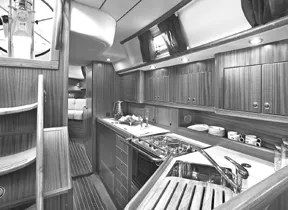
The engine is sited beneath the companionway. You can get at it easily by lifting the stairs; a dip-stick portal opens to port, and a removable cockpit panel affords virtually 360-degree access. Certainly big enough for the boat, this 54-hp diesel sits atop four rubber mounts and is attached to the shaft via a flexible coupling, all of which explains its vibration-free performance. Inch-thick foam insulates the entire lighted compartment, deadening the sound remarkably well. The fuel tank and the fresh water tanks are made of stainless steel.
Performance
Her four-cylinder Yanmar was hardly audible. Vibration was minimal, too. As soon as we found space to open the throttle we pushed it. The boat jumped to 6.5 knots at slightly more than 2,200 rpm in moderately flat water, and there was plenty of power in reserve.
One of the nicest surprises of our time on board was the 380’s roller-furling main. Set up on an in-mast furler from UK Syverson, the sail offered much more horsepower than the roach-reduced mains that we’ve come to associate with in-mast furling systems. Not only was its area adequate to its task, it set well. The secret, we learned, was in the vertical battens arrayed along the leech. Sails like these have been around for almost five years, but PS has had little experience with them. Actually using one under sail, we were taken with how wrinkle-free it remained and how relatively friction-free it was to set and furl. Taming the main is an essential element in making a boat like the 380 (which carries a proportionately large mainsail) easy to sail. Vertical batten technology seems to offer significant advantages in this area.
Our test boat had variable speed electric winches: the harder you press the button the faster the winch turns. We encountered very few waves and no whitecaps during our test sail, but we still got a definite sense that the boat was close-winded. Registering a 35-degree apparent wind angle at better than 1/3 the true wind speed while making minimal leeway, the 380 looked a lot like the ideal upwind cruising boat. After a few tacks we were also taken with her maneuverability. The boat answered the helm rapidly and consistently. When we applied the “hands off” test, she also tracked straight for minutes at a time, a tribute to the balance of her sailplan coupled with the appropriate sizing of her skeg.
In such a benign breeze, however, her relatively small headsail seemed to make her a bit slow in accelerating. It was longer before she started to make her own wind on a new tack, we felt, than it might have been had we been flying a larger headsail. We recorded an average of just under 90° between tacks. What little we could determine about her stability we liked; her rail stayed well clear of the water even when we reached along with the main strapped in tight in the occasional 14-knot puffs.
Because the working sails on the 380 we tested were each furled, sailhandling was a simple affair. The mainsail and the headsail (on a Selden Furlex system) deployed and retracted flawlessly.
Conclusions
It’s now been decades since the heyday of the masthead sloop driven by a big genny and a minimal mainsail. Still, most cruising boats remain closer to that archetype than to the more sensible sail plan we favor. We applaud Judel-Vrolijk & Co. because, instead of re-drawing a raceboat and selling it to a cruising builder, they have invested creditable amounts of time and experience in a boat designed to sail the way cruisers really sail.
Najad knows its niche and has prospered by filling it with sensible, sound, (but certainly expensive) auxiliaries. Its all-round commitment to quality and especially its exquisite production joinery place it among the world’s best production (or semi-custom) builders. However, exterior wood, even one as traditional as teak, is overused here, in our opinion. While it is somewhat a matter of taste, we quarrel with the cosmetic use of teak because it adds weight as well as upkeep. Finally, while we applaud the resources and expertise brought to the design by Judel-Vrolijk & Co., it seems to us that the application of their go-fast knowledge and experience has been curtailed somewhat by the builder’s emphasis on tradition.
Contact – Najad (Scandinavian Yachts, Inc.), 401/846-8442, www.najad.se.
Also With This Article
“Najad 380 In Context”
“Construction”


